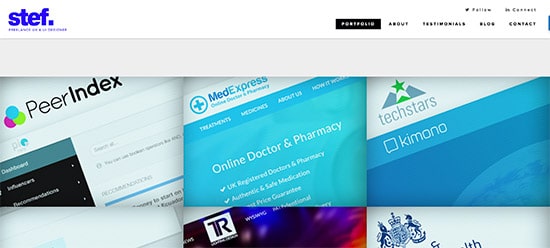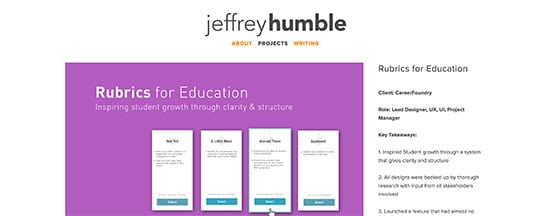How to Create a Breathtaking UX Portfolio
Starting or progressing your career in UX? If you’re not already up to date with the industry, you’ll need to know just how important a portfolio is to your application. The UX industry is taking off beyond belief. It’s becoming more important than ever before to create an outstanding UX portfolio that will set you apart from the rest of the candidates.
Today, I’m going to talk you through in order to create your interview-securing portfolio and land your dream job.
Decide on Your Formatting
The first thing you’re going to want to do is to decide the format in which your UX portfolio is going to be presented in. You could try doing a physical copy in a nice, bonded folder. However, this is going to be extremely costly, especially when you want multiple versions of them. You’ll need to keep your UX portfolio up to date.
This leads people to want to create a digital PDF version, but this doesn’t have the desired effect when it comes impressing a recruiter. With this in mind, your most effective approach to take is to create a portfolio website. Not only is this extremely convenient for employers, but it’s also easy to update and a great opportunity for you to showcase your UX skills.
For example, check out this example of a UX portfolio by the UK’s leading Stef Ivanov. You can see an extensive range of projects that he’s worked on in a clear, visual and easy to read format which is ideal for clients.
Showcase Your Skills
As a UX designer, you might have experience as a web designer, in graphic design and even coding. No matter what your personal skills are, your UX portfolio is the best place to highlight them.
When it comes to UX, there are two main niches that you would class yourself as; a researcher or a designer. Of course, a researcher has the task of conducting studies, process and experiments into what kind of experience a user will be looking for and will respond well to.
A researcher will also be responsible for compiling the results, drawing conclusions and then figuring out how this benefit user design and their experience.
On the other hand, a designer is somebody that puts this information and research into practice but building designs, websites, software interfaces etc. with this knowledge in mind, enabling them to provide their users with the best experience possible.
Typically, many people believe that a UX designer simply designs, but there is a clear difference between the two. When it comes to your portfolio, you need to make sure that you’re describing yourself as clearly as possible. Make it easy to understand which ‘bucket’ you have more experience in.
So, when writing your portfolio, make sure that you include samples of your work or experience based on whichever bucket you’re classed as. In some cases, you may be classed as both, commonly referred to as a ‘unicorn‘, which means you’ll need to provide balanced examples from both sides.
“Try to share many different examples of the work you did. Then the recruiter has everything to make the right decision.”
You may also like to talk people through your work process, just as Jeffrey Humble has done on his website in his portfolio section.
Jeffrey shows work that he has produced as well as a breakdown of the key aspects of the project. The main targets, some background information on the client, the interfaces he has designed and why he made certain decisions.
It’s a great way of showing off his skills to potential clients. They’ll have very little questions to ask him when it comes to a new project or service that they require.
Designing Your UX Portfolio
With these consideration in mind, you may be wondering about the best way to showcase your individual skills and yourself.
As a researcher, you’ll need to provide samples of your past and, most importantly, the processes you took when trying to complete and carry out a certain task. This means you’ll need to share your process on how you went about starting, preparing and carrying out your study. What special considerations did you need to think about to ensure accuracy?
You’ll also want to share proof of how your study and research has been implemented in a real-world situation. For example, you could include before and after shots of a website you’ve worked on as well as sharing examples from some of the projects you have been working on.
On the other hand, if you’re a designer, you’ll need to focus on your process. How did you obtain information from a researcher or source? How did you implement into the design? You’ll also want to consider things like client requirements and feedback from users.
Like a researcher, you’ll want to include before and after screenshots of a website or product that you’ve been working on. You could also add some examples of your process along the way. Include analytical information, such as spikes in user activity after you’ve implemented a change or update.
Whichever approach you’re taking, make sure that everything is clearly labelled and captioned. That way the employer can easily follow what you’ve been doing.
Finalising Your Portfolio
Although you may not have much text in your portfolio, it’s important that the text you do use is accurate and of the highest quality. Otherwise, you’ll damage your credibility as a professional. Here are some online tools you can use to help:
Via Writing / Grammar Check
These are two online grammar checkers you can use to improve the quality of your portfolio.
Resume Writing Service
A resume-building website that can help with the creation of a UX portfolio.
Paper Fellows / UKWritings
These are two professional proofreading tools, as recommended by the HuffingtonPost.
State of Writing / My Writing Way
These are two sites full of writing guides you can use and follow when writing the content for your portfolio.
Academized
This is a resume-writing tool you can use to write your resume to accompany your portfolio, as reviewed by Best British Essays.
Cite It In / Easy Word Count
These are two free online tools you can use to add quotes and references to your portfolio or to track your overall word count.
Include References from Past Roles
It’s important to include quotes, references or reviews from past businesses or clients that you’ve worked with. This is a great way for an employer to see what kind of person you are and how you work.
Be Personal
The best thing about a portfolio is the fact that it’s yours and you need to make this clear in it. Tell your story and show what kind of person you are and what it’s like to be working with you.
Bear in mind that hundreds of people could be applying for the same job. You’ll need to make sure you’re doing all you can to help yourself stand out from the crowd.







My biggest issue with UX portfolios is that people LOVE to show the final product, even though there is little to know chance they actually worked on the final product.
Most UXers do not produce the final design or code it.
Don, I totally agree.
Thanks for featuring my portfolio!
Thank you for sharing this article.